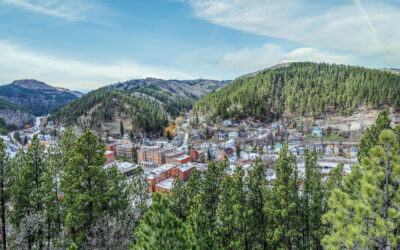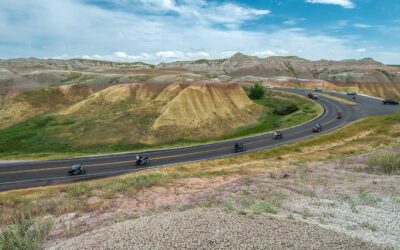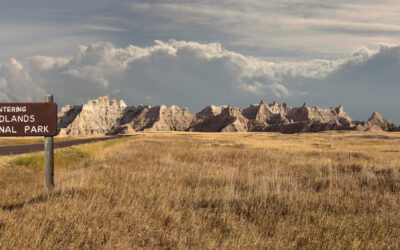South Dakota, a land of rugged beauty and historical grandeur, beckons travelers to embark on a journey through time. From the majestic formations of the Badlands to the iconic faces of Mount Rushmore, the state offers a plethora of sites where history and nature intertwine. The open roads lead to encounters with wildlife at Custer State Park, explorations of the underground marvels at Jewel Cave National Monument, and quirky pit stops that capture the heart of American road trip culture. This article delves into South Dakota’s historic sites, offering a guide to the timeless adventures that await in the Midwest.
Key Takeaways
- South Dakota’s Badlands National Park offers breathtaking landscapes and family-friendly adventures, teeming with trails and wildlife.
- Mount Rushmore stands as a testament to American history, where visitors can learn about its creation and hike surrounding trails.
- Custer State Park is a wildlife haven where one can witness herds of buffalo and enjoy scenic drives and outdoor activities.
- Jewel Cave National Monument provides an awe-inspiring subterranean experience along with surface trails showcasing the Black Hills.
- Unique roadside attractions like Wall Drug and the Corn Palace enrich the road trip experience with cultural and historical charm.
Exploring the Majestic Badlands
Unearthing the Rugged Beauty
The Badlands of South Dakota offer a stark and profound beauty that is as compelling as it is unique. The rugged terrain, with its sharply eroded buttes, pinnacles, and spires, beckons the adventurous spirit to explore its depths. This geological wonder, sculpted by water and wind over millions of years, is a testament to the raw power of natural forces.
Visitors to the Badlands can immerse themselves in the park’s rich paleontological history, where ancient mammals once roamed. The layered rock formations reveal a fossilized world, making it a prime location for those interested in unearthing the secrets of the past. The park’s striking landscapes are not only a visual feast but also a scientific treasure trove, offering insights into the Earth’s evolutionary history.
- Fossil Exhibit Trail: A must-visit for enthusiasts, showcasing the area’s rich fossil beds.
- Door Trail: Provides an accessible route into the Badlands’ dramatic landscapes.
- Notch Trail: Offers a more challenging hike with rewarding views of the White River Valley.
As one of South Dakota’s top attractions, the Badlands is a cornerstone of the unique experiences available in Western South Dakota. It’s a place where history is written in the stones, and every visit feels like a step back in time.
A Family Favorite Adventure
The Badlands of South Dakota offer a unique opportunity for families to bond over shared experiences and create lasting memories. The rugged terrain, with its layered rock formations and steep canyons, provides a natural playground that both educates and entertains. Children and adults alike marvel at the ancient geological wonders, while learning about the area’s rich fossil history.
The park’s accessibility makes it a hit with families. Numerous trails cater to all skill levels, ensuring that everyone, from the enthusiastic toddler to the more cautious grandparent, can enjoy the adventure. Here’s a quick guide to family-friendly trails:
- Door Trail: An easy 0.75-mile boardwalk that offers stunning views and is suitable for strollers.
- Window Trail: A short 0.25-mile loop that leads to a natural window in the rock formations.
- Notch Trail: A moderate 1.5-mile hike with a ladder climb and rewarding views of the White River Valley.
Remember, the journey is as important as the destination. The Badlands provide a canvas for those small adventures and mishaps that become the stories retold at family gatherings for years to come. From the thrill of spotting wildlife to the challenge of navigating the trails, each moment contributes to the tapestry of a family’s travel narrative.
Wildlife and Hiking Trails
The Badlands National Park offers an ultimate guide to the best hikes, catering to both casual walkers and seasoned trekkers. The park’s diverse terrain includes the popular Notch Trail, which promises stunning views and a bit of a challenge with its log ladder. For those seeking a more leisurely stroll, the Window Trail provides a quick and easy path to breathtaking overlooks.
Wildlife enthusiasts will appreciate the chance to observe the park’s unique fauna. Keep your eyes peeled for the swift fox, bighorn sheep, and the elusive black-footed ferret, one of North America’s rarest mammals. Here’s a quick list of trails that combine the best of wildlife spotting and scenic hiking:
- Notch Trail: A moderate 1.5-mile hike with ladder climb and canyon views.
- Castle Trail: The park’s longest at 10 miles, offering a full day’s adventure.
- Window Trail: A short 0.25-mile walk to a natural window in the Badlands Wall.
- Fossil Exhibit Trail: A 0.25-mile boardwalk featuring fossil replicas and educational displays.
Each trail offers a unique perspective of the Badlands’ rugged beauty, ensuring that every visitor leaves with a deeper appreciation for this ancient landscape.
The Iconic Mount Rushmore Experience
Faces of American History
Mount Rushmore is not just a colossal sculpture but a canvas that tells the story of America’s evolution. Carved into the granite face of Mount Rushmore are the heads of four presidents who each represent a different aspect of American history. George Washington signifies the birth of the United States, Thomas Jefferson reflects the idea of democracy, Theodore Roosevelt embodies the role of the U.S. on the world stage, and Abraham Lincoln stands for the preservation of the Union and the end of slavery.
The creation of Mount Rushmore was an engineering marvel, involving the efforts of over 400 workers from 1927 to 1941. Despite the dangerous conditions, not a single life was lost during the construction. Here’s a brief timeline of the monument’s development:
- 1927: The project begins with Gutzon Borglum’s vision.
- 1933: The National Park Service takes over the project management.
- 1939: Jefferson’s face is completed.
- 1941: The sculpture is declared complete with the finishing of Lincoln’s face.
Visitors today can explore the Lincoln Borglum Visitor Center to learn more about the history and making of this national treasure. The Presidential Trail offers an up-close view of the monument, and the Evening Lighting Ceremony provides a poignant reminder of the enduring legacy of these four presidents.
Sculpting a National Treasure
The creation of Mount Rushmore is a tale of human triumph and artistic endeavor. Gutzon Borglum, the visionary American sculptor, embarked on this colossal project in 1927, transforming the Black Hills of South Dakota into a canvas of national pride. The idea of creating a monumental sculpture in the Black Hills was first suggested in 1923 by South Dakota state historian Doane Robinson, who envisioned it as a means to promote tourism in the region.
The process of sculpting Mount Rushmore was a Herculean task that involved the precise coordination of laborers, the innovative use of dynamite, and the delicate art of fine detailing. Borglum’s dedication to the project was unwavering, and his ability to see beyond the granite face to the figures of four great American presidents was nothing short of extraordinary.
- 1927: Project initiated
- 1933: Federal government takes over funding
- 1941: Sculpture completed
Despite the challenges, including financial constraints and harsh weather conditions, the project reached completion in 1941. Today, Mount Rushmore stands as a testament to the determination and skill of all those who contributed to its creation, and it continues to draw millions of visitors each year.
Visitor Tips and Trails
Mount Rushmore National Memorial offers more than just a monumental view; it’s a journey through American history set in stone. To make the most of your visit, start at the Lincoln Borglum Visitor Center. Here, you’ll find educational exhibits and a short film that provides context to the colossal faces gazing down upon you.
When you’re ready to explore, the Presidential Trail is a must-do. This 0.6-mile loop offers the closest views of the sculpture and is accessible for most visitors. For a more serene experience, consider visiting early in the morning or later in the evening to avoid the crowds.
Don’t forget to pop into the Sculptor’s Studio to learn about the intricate process of carving and blasting that brought Mount Rushmore to life. And remember, the weather can be unpredictable, so dress in layers and wear comfortable shoes.
Lastly, check the park’s website for scheduled events that might enhance your visit, such as evening lighting ceremonies or ranger-led talks. With a little planning, your trip to Mount Rushmore will be an unforgettable experience.
Buffalo Galore at Custer State Park
The Great Buffalo Encounter
Custer State Park is a sanctuary for one of America’s most iconic creatures, the buffalo. Witness the majestic buffalo roundup, an annual event that transforms the park into a scene reminiscent of the Old West. Nearly 1,300 buffalo are herded by cowboys into corrals, a spectacle that attracts visitors from all over the world. This event not only provides an unforgettable experience but also serves a crucial role in the management and conservation of the buffalo population.
The park’s efforts to maintain a healthy and balanced ecosystem can be seen through their careful monitoring and management practices. Visitors have the unique opportunity to observe these magnificent beasts in their natural habitat, roaming the rolling prairies and grazing on the native grasses. The buffalo encounter is more than just a viewing; it’s an immersive experience that connects you to the raw power and beauty of nature.
Here are some tips to enhance your buffalo encounter at Custer State Park:
- Stay safe: Always keep a safe distance from the buffalo; they are wild animals and can be unpredictable.
- Use binoculars: To get a closer look without disturbing the buffalo, bring a pair of binoculars.
- Attend the roundup: Plan your visit around the buffalo roundup for a chance to see this incredible event.
- Explore responsibly: Stick to designated areas and trails to minimize your impact on the environment and wildlife.
Scenic Drives and Picnic Spots
Custer State Park’s scenic drives are an invitation to immerse oneself in the natural splendor of South Dakota. The Wildlife Loop Road, a highlight of the park, offers a leisurely drive through rolling prairies where the buffalo roam. This 18-mile stretch is not just a drive but an experience, with pullouts that allow for impromptu picnics and wildlife viewing.
For those seeking a picturesque spot to dine al fresco, the park provides several designated picnic areas. Each is equipped with tables and grills, nestled in settings that range from serene meadows to creekside oases. Here’s a quick guide to some of the most popular picnic spots:
- Stockade Lake North: Ideal for families, with easy access to fishing and boating.
- Legion Lake: A serene setting with a backdrop of granite peaks.
- Game Lodge: A historic area where buffalo often graze nearby.
Whether you’re packing a gourmet spread or grabbing sandwiches from the park store, these drives and picnic spots are sure to enhance your South Dakota adventure. Remember, the best way to enjoy the park is to leave no trace and preserve its beauty for future visitors.
Outdoor Activities for Everyone
Custer State Park is a haven for outdoor enthusiasts, offering a plethora of activities that cater to all ages and skill levels. With 71,000 acres of land in the Black Hills of South Dakota, the park is a playground for nature lovers seeking adventure or relaxation in the great outdoors.
For those looking to immerse themselves in the natural beauty of the park, there are numerous hiking trails that range from easy strolls to challenging treks. Mountain biking trails provide an adrenaline rush for cyclists, while rock climbing spots attract climbers from all over. Here’s a quick guide to some of the activities you can enjoy:
- Hiking: Explore diverse trails with varying difficulty levels.
- Mountain Biking: Ride through scenic landscapes on well-maintained tracks.
- Rock Climbing: Test your skills on the park’s granite peaks.
- Fishing: Cast a line in the park’s lakes and streams.
- Wildlife Viewing: Keep an eye out for the park’s famous bison herds and other wildlife.
Whether you’re planning an epic camping trip or a day visit, Custer State Park is a destination that promises memorable experiences for everyone. Remember to pack accordingly for your chosen activities, and always respect the park’s natural habitat to ensure it remains a treasure for generations to come.
Jewel Cave National Monument: A Subterranean Journey
Discovering the Hidden Gem
Nestled in the rugged expanse of the Black Hills, Jewel Cave National Monument offers a rare glimpse into the delicate and complex beauty that lies beneath our feet. Discovered in 1900, this subterranean wonder captivates with its sparkling calcite crystals and intricate natural formations.
As you embark on your adventure into the cave, you’ll encounter a tapestry of natural art. The cave’s features include:
- Nail Spar
- Frostwork
- Flowstone
Stretching over 200 miles, much of Jewel Cave remains uncharted, a testament to nature’s capacity to create unparalleled beauty over millennia. This rich karst terrain is not only a geological treasure but also a sanctuary for rare wildlife, contributing to vital conservation efforts.
When planning your visit, remember that exploring South Dakota’s underground treasures is more than a journey; it’s an act of preserving our planet’s legacy and enriching our own connection with the natural world.
Preserving the Jewel
The National Park Service’s commitment to the conservation of Jewel Cave National Monument is pivotal in maintaining the integrity of this subterranean wonder. By managing the cave’s delicate ecosystem and geological formations, the Park Service ensures that the cave remains a source of inspiration and education for future generations. The ongoing exploration and preservation efforts are a testament to the cave’s enduring allure and its importance as a natural heritage site.
Jewel Cave is not just a geological marvel; it’s a living museum that tells the story of the earth’s past. The cave’s intricate formations, such as Nail Spar, Frostwork, and Flowstone, are a testament to the natural artistry that has been sculpted over millennia. Visitors are invited to embark on a journey into the depths, where they can marvel at the vast chambers and narrow passageways that make up over 200 miles of explored territory.
Above ground, the monument offers a different experience with surface trails that showcase the Black Hills’ natural beauty. Hiking these trails provides a glimpse into the area’s rich biodiversity and panoramic views. Whether underground or above, a visit to Jewel Cave is an adventure into the heart of our planet’s hidden wonders.
Above Ground Treasures
While the subterranean wonders of Jewel Cave National Monument are undoubtedly the main attraction, the surface of this remarkable site offers its own array of natural treasures. Above ground, a network of trails beckons visitors to explore the diverse landscape of the Black Hills. These trails are perfect for witnessing the area’s rich biodiversity, where the chance to spot local wildlife is as enticing as the panoramic views.
The surface trails at Jewel Cave provide a unique opportunity to appreciate the monument’s beauty from a different vantage point. Whether you’re an avid hiker or simply enjoy a leisurely walk, these paths offer a chance to connect with nature and gain a deeper understanding of the region’s ecological significance.
- Canopy of Ponderosa Pines
- Wildflower Meadows
- Birdwatching Hotspots
After delving into the depths of Jewel Cave, take the time to experience the above ground wonders that contribute to the monument’s status as a cherished natural site. The Black Hills’ landscape is a testament to the area’s geological history and the ongoing efforts to preserve its pristine condition for future generations.
Quirky Stops Along the Way: Wall Drug and the Corn Palace
Wall Drug: More Than Just a Drugstore
Nestled in the prairies of South Dakota, Wall Drug has evolved from a humble drugstore to a sprawling emporium that captures the essence of American road trip culture. A beacon for travelers on Interstate 90, Wall Drug offers a quirky and nostalgic experience that goes beyond the conventional pit stop.
The store’s eclectic mix of offerings includes everything from classic souvenirs and local art to a collection of historical photographs that tell the story of the Midwest. Visitors can explore a variety of shops within Wall Drug, each with its own unique charm and selection of goods.
- Home to a range of products, including posters and artist proofs that celebrate the natural beauty of national parks.
- Collections that feature canvas prints, postcards, and stickers, perfect for commemorating your visit.
- Community initiatives that showcase Wall Drug’s commitment to giving back and engaging with the local culture.
Whether you’re looking for a piece of Americana or just a break from the road, Wall Drug is a must-visit destination that embodies the spirit of South Dakota’s diverse attractions.
The Corn Palace: A Unique Cultural Icon
Nestled in the heart of Mitchell, South Dakota, the Corn Palace stands as a testament to the region’s agricultural heritage and creative spirit. This one-of-a-kind structure is not only a visual spectacle but also a venue for community events, sports, and entertainment. Each year, the Corn Palace is redecorated with naturally colored corn and other grains, creating elaborate murals that tell stories of South Dakota’s culture and history.
The Corn Palace’s origins date back to 1892, and it has since become an emblem of ingenuity and local pride. Visitors can explore the interior’s corn murals, which are crafted by local artists and vary annually, ensuring a unique experience with every visit. Here’s a quick glimpse at the Corn Palace’s annual transformation:
| Year | Theme | Number of Ears of Corn Used |
|---|---|---|
| 2021 | ‘South Dakota Homegrown’ | Over 275,000 |
| 2022 | ‘South Dakota Adventures’ | Approximately 300,000 |
| 2023 | ‘South Dakota Innovations’ | Nearly 325,000 |
Beyond the murals, the Corn Palace Festival, held each August, offers a vibrant mix of live music, food, and crafts, celebrating the region’s agricultural bounty. Whether you’re a history buff, art enthusiast, or simply looking for a quirky pit stop, the Corn Palace is a must-see destination that encapsulates the spirit of the Midwest.
Creating Memories at Roadside Attractions
The allure of roadside attractions goes beyond their quirky facades and into the heart of family lore and shared experiences. South Dakota’s Wall Drug and the Corn Palace stand as testaments to this tradition, offering a blend of history, novelty, and a touch of Americana that continues to draw travelers from all corners. These stops are more than mere distractions; they are waypoints on the journey of discovery, where every kitschy souvenir and photo op becomes a piece of the narrative we carry with us long after the vacation ends.
The Corn Palace, for instance, is not just an architectural marvel but also a cultural hub that showcases the region’s agricultural heritage. Similarly, Wall Drug, once a simple pharmacy, has evolved into a sprawling emporium of curiosities, famous for its free ice water and iconic signage that dots the highways leading to it. Here’s a quick list of what to expect at these iconic South Dakota stops:
- Free ice water and 5-cent coffee at Wall Drug
- The Corn Palace’s annually redesigned murals made of natural grains
- A treasure trove of memorabilia and unique gifts
- Photo opportunities with larger-than-life sculptures
As you plan your visit, remember that these attractions are steeped in a rich history that intertwines with the very roads that lead to them. They are part of a legacy of the American road trip, a nod to the days when families would pile into their ‘land yachts’ and set off in search of adventure, guided by fold-out maps and the promise of the open road.






